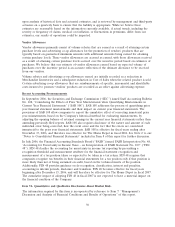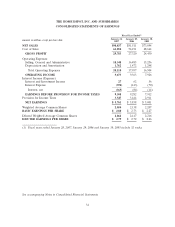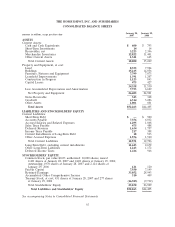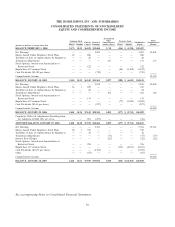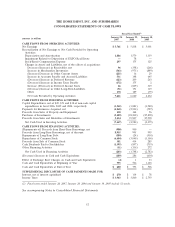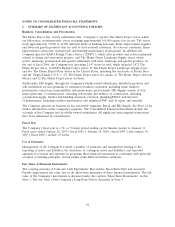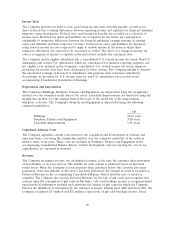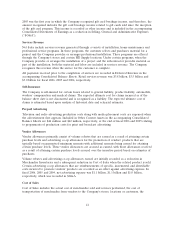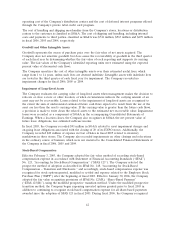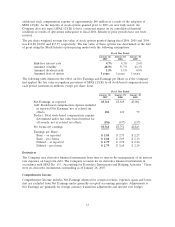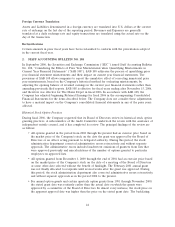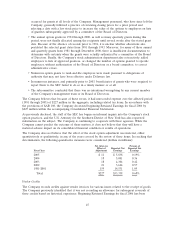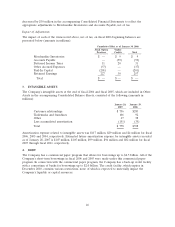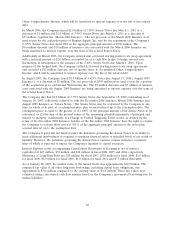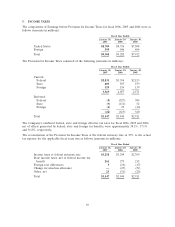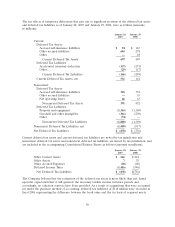Home Depot 2006 Annual Report Download - page 50
Download and view the complete annual report
Please find page 50 of the 2006 Home Depot annual report below. You can navigate through the pages in the report by either clicking on the pages listed below, or by using the keyword search tool below to find specific information within the annual report.
Income Taxes
The Company provides for federal, state and foreign income taxes currently payable, as well as for
those deferred due to timing differences between reporting income and expenses for financial statement
purposes versus tax purposes. Federal, state and foreign tax benefits are recorded as a reduction of
income taxes. Deferred tax assets and liabilities are recognized for the future tax consequences
attributable to temporary differences between the financial statement carrying amounts of existing
assets and liabilities and their respective tax bases. Deferred tax assets and liabilities are measured
using enacted income tax rates expected to apply to taxable income in the years in which those
temporary differences are expected to be recovered or settled. The effect of a change in income tax
rates is recognized as income or expense in the period that includes the enactment date.
The Company and its eligible subsidiaries file a consolidated U.S. federal income tax return. Non-U.S.
subsidiaries and certain U.S. subsidiaries, which are consolidated for financial reporting purposes, are
not eligible to be included in the Company’s consolidated U.S. federal income tax return. Separate
provisions for income taxes have been determined for these entities. The Company intends to reinvest
the unremitted earnings of its non-U.S. subsidiaries and postpone their remittance indefinitely.
Accordingly, no provision for U.S. income taxes for non-U.S. subsidiaries was recorded in the
accompanying Consolidated Statements of Earnings.
Depreciation and Amortization
The Company’s Buildings, Furniture, Fixtures and Equipment are depreciated using the straight-line
method over the estimated useful lives of the assets. Leasehold Improvements are amortized using the
straight-line method over the original term of the lease or the useful life of the improvement,
whichever is shorter. The Company’s Property and Equipment is depreciated using the following
estimated useful lives:
Life
Buildings 10-45 years
Furniture, Fixtures and Equipment 3-20 years
Leasehold Improvements 5-45 years
Capitalized Software Costs
The Company capitalizes certain costs related to the acquisition and development of software and
amortizes these costs using the straight-line method over the estimated useful life of the software,
which is three to six years. These costs are included in Furniture, Fixtures and Equipment in the
accompanying Consolidated Balance Sheets. Certain development costs not meeting the criteria for
capitalization are expensed as incurred.
Revenues
The Company recognizes revenue, net of estimated returns, at the time the customer takes possession
of merchandise or receives services. The liability for sales returns is estimated based on historical
return levels. When the Company receives payment from customers before the customer has taken
possession of the merchandise or the service has been performed, the amount received is recorded as
Deferred Revenue in the accompanying Consolidated Balance Sheets until the sale or service is
complete. The Company also records Deferred Revenue for the sale of gift cards and recognizes this
revenue upon the redemption of gift cards in Net Sales. Gift card breakage income is recognized based
upon historical redemption patterns and represents the balance of gift cards for which the Company
believes the likelihood of redemption by the customer is remote. During fiscal 2006 and fiscal 2005, the
Company recognized $33 million and $52 million, respectively, of gift card breakage income. Fiscal
40


